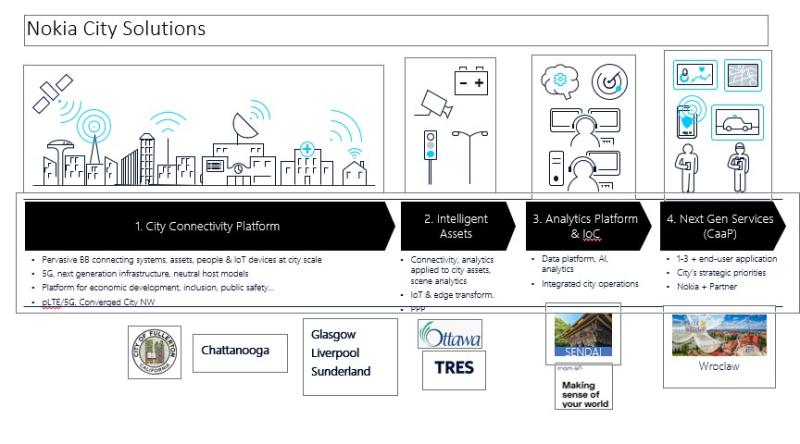Another in a series from speakers at Sensors Converge 2023
Q: Smart cities discussions and planning have been going on for a decade. Lately, however, has the wind dropped out of the sails or is this still a vital market? What evidence do you have?
Allison: Cities are attending more smart city events and shows, collecting data and engaging with technology companies to help them develop a smart city strategy. The market has slowed down due to the infrastructure funding coming from the federal government as cities await funding mechanisms. It’s clear that smart cities approaches are the key to driving ESG goals, decarbonization, lower operation costs and driving public safety.
Also, what I’m seeing is that everybody loves the vision of smart city. At the Smart City Connect event recently, Nokia had a booth and good turnout. Asia and Europe are way more advanced than the US is. There’s a lot of infrastructure money from the US federal government coming to the states. Additional funding will drive adoption. A lot of cities are waiting on funding mechanisms.
Many cities are interested in smart cities, but don’t know how to get there and they need to collect different departments or units in the city. Thought leadership is critical to smart city adoption.
Nokia is working with quite a few cities at different stages. Some are building the infrastructure piece and private wireless to connect smart city apps and IoT devices. We work to build a roadmap or blueprint along with partners to bring end-to-end solutions.
Q: Are any US cities doing well on the smart city pathway?
Allison: Yes, some are building the broadband infrastructure and are at early stages. Some cities look at it as entire solution while others take a siloed approach that can lead to interoperability problems. It’s better to look at it holistically.
Q: What’s the smartest city in the US?
Allison: Good question. One source, ProptechOS, recently ranked Austin, L.A., Seattle and San Francisco at the top of the list for “smart potential.” That was for categories such as tech infrastructure, green infrastructure, available EV charging, local IoT companies, and free public Wi-Fi. Austin was high with green infrastructure and EV access.
Sometimes, cities get honored for only pinpoint apps. I work with them on broadband and wireless for an entire ecosystem. If they work a smart parking app, I don’t get involved, but I help create a blueprint. Smart pole adoption is also really big. Smart poles will be critical in a smart city to provide video analysis, gunshot detection, smart lighting, environmental monitoring, bringing out the network to the edge and 5g and Wi-Fi and private wireless. Smart poles tie everything together. With a combination of wireless and fiber and smart pole, you can connect it all. That’s critical.
Q: How does one even start with building an “ecosystem strategy,” which is a phrase mentioned in the promotional language for your Sensors Converge appearance? How do you wrangle city governments and activists in today’s climate?
Allison: Work with industry-leading technology partners and a consultant that can drive an end-to-end smart city roadmap. The key is to have an efficient smart city infrastructure and ecosystem.
You have to work with city leadership for a smart city strategy and sell that to different department heads and then build a blueprint and step into smart cities so it all interoperates together. Do a security blanket around the right solution set. And work with consultants that specialize, alongside partners. I have a whole ecosystem of partners to build fiber and develop a roadmap for building blocks, from foundation to edge of the network.
Q: What’s one of the most striking actual examples you can cite of a key enabling tech and where it was used and to what benefit? Is it an ROI play in many cases?
Allison: Fiber and a private LTE network are key enablers that will make a solid foundation for a smart city platform. Smart poles will enable apps and change the game for smart city deployments. Reduced costs will create an excellent ROI in most cases.
Of course, ROI can get complicated. What we try to do is build fiber to collect revenue, both commercial and residential, and with an ISP de-risk the network. Smart city apps don’t generate a lot of revenue, but with most apps there is a lower cost. For example, smart parking can gen revenue and reduce costs. Smart lighting on smart poles reduces costs and helps with decarbonization. Cities can lower costs and improve efficiencies and drive new revenue through data monitization. You see examples in airports.
Q: Can you name any gotchas in planning a smart city?
Allison: Not building in a silo architecture, which is inefficient to manage and maintain.

Mike Allison is head of government and cities for Nokia North America. His responsibilities including driving smart cities, fiber broadband networks and Nokia’s partner ecosystem. He is speaking at Sensors Converge 2023 at 8:30 a.m. PT on June 22 on a leaders’ roundtable on the topic of “Building an Intelligent Infrastructure Ecosystem from Mobility to Smart Cities and Beyond.” Sensors Converge runs June 20-22 in Santa Clara, California. Registration is online.